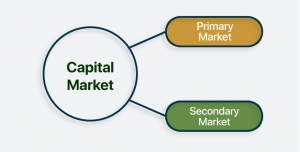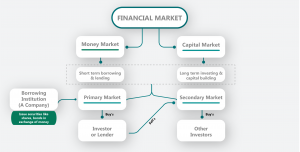The world of finance can be intimidating for newcomers, with complex terms and seemingly intricate processes. However, understanding the basic structure is crucial for anyone interested in investing. Two fundamental concepts you’ll encounter are primary markets and secondary markets. Let’s delve into the nuances of each and how they work together to keep the financial engine running.
The Indian capital market is divided majorly into two primary segments: the primary market and the secondary market. Although there are differences between these two types of markets, they serve one common purpose- to act as platforms where the buying and selling of financial assets, such as bonds, equity, and securities, take place.
Investors need to understand the nature and characteristics of these markets, as well as recognize the disparities between the primary and secondary markets.


Primary Market: Meaning
The primary market plays a pivotal role in the economy by serving as a financial platform where newly issued bonds, or other financial instruments, are introduced and sold for the first time by companies, governments, and entities. Through the issuance of securities in the primary market, these entities can access an investor base, raising capital to support their growth, expansion, and various projects.
In the primary market of bonds, there are majorly two ways in which bonds can be issued:
- Public Offering: This is just like an IPO in the stock market. The company in its prospectus announces the bond issuance with specific details like interest rate, maturity date, and total amount to be raised. These bonds are then offered to a broad range of investors, typically through investment banks. The issuer considers prevailing market interest rates, creditworthiness (as reflected in credit ratings), and overall investor demand to determine the final interest rate offered on the bond.
- Private Placement of Bonds: Companies can also choose to sell bonds directly to a selected group of qualified investors. This might include institutional investors like mutual funds, pension funds, or insurance companies. Private placements often involve larger bond denominations and may offer slightly different terms compared to publicly offered bonds.
Whether a public offering or private placement, bonds typically need to be registered with regulatory bodies to ensure investor protection and transparency. Publicly offered bonds are then accessible to a wider range of investors, while privately placed bonds are restricted to those who qualify under the regulations.
Key Players in the Primary Market:
Issuing Company: The company seeking capital by selling new securities.
Investment Banks: These institutions act as intermediaries, helping companies structure the offering, market it to investors, and facilitate the sale.
Underwriters: Investment banks often act as underwriters, guaranteeing to buy any unsold securities, reducing the risk for the issuing company.
Institutional Investors: Large investors like pension funds, mutual funds, and insurance companies are major players in the primary market, seeking attractive investment opportunities.
Features of the Primary Market
The primary market has distinctive features that set it apart from secondary markets.
- Regulation- The primary market is controlled by securities laws and regulations to protect investors and to ensure that issuers adhere to proper disclosure requirements. Government bonds are regulated by the Reserve Bank of India (RBI) and corporate bonds by the Securities and Exchange Board of India (SEBI).
- Issuance of New Securities- The primary market is where newly issued debt instruments are introduced and sold for the first time to the public through public offerings or offered to a specific set of investors via private placements.
- Issuer-determined Pricing- In the primary market, the pricing of securities is determined by the issuer based on market conditions and demand.
- Direct relationship between issuers and investors- In the primary market, issuers raise funds directly from investors by making securities available to the public or specific investor groups.
- The primary debt market in India is well-established, offering a diverse range of debt instruments tailored to suit different investor preferences, tenors, and credit profiles.
Pros and Cons of Primary Market
Pros
- Capital Formation: Companies raise much-needed funds for growth and expansion.
- Access to New Prospects- By participating in the primary market, investors gain entry to fresh investment prospects in companies, sectors, and industries that may not be available in the secondary market.
- Pricing Advantage- Investors in the primary market can enjoy a pricing advantage, as the securities are often available at a face value compared to what they would be in the secondary market.
Cons
- Higher Risk- Investing in the primary market carries a higher level of risk compared to the secondary market as the securities have yet to undergo market testing.
- Lack of Information- Investors may have limited information about the issuer in the primary market, as the company may not have a public track record due to the limited public track record of the issuer. While the information might be limited for some companies in the primary market, regulations ensure that for public offerings of bonds, investors have access to a detailed document (the prospectus) to make informed decisions to enhance transparency and protect the retail investors.


Secondary Market: Meaning
The secondary market in bonds is a financial market where the trading of existing debt securities like bonds, NCDs, and notes takes place among investors without the involvement of the original issuer. The prices of securities are determined by supply and demand dynamics. It provides liquidity to investors, allowing them to convert their securities into cash or find better investment opportunities elsewhere.
The secondary market is vital for the proper functioning of the financial system as it facilitates the buy and sell of securities that are already issued from one investor to another, thereby enhancing the efficiency and liquidity of the market. Investors can also adapt their portfolios and manage risk exposure effectively.
Features of the Secondary Market
- The secondary market is regulated by the Reserve Bank of India (RBI) for government bonds and the Securities and Exchange Board of India (SEBI) for corporate bonds. These regulations are made to safeguard investors and maintain the market’s integrity.
- Trading of Existing Securities- The secondary market is where investors engage in the buying and selling of previously issued securities that have already been issued by entities like companies or governments in the primary market.
- Market-driven Pricing- Pricing in the secondary market is determined by market supply and demand among investors. Thus, the price is subject to fluctuations based on prevailing market conditions and investor sentiment.
- Debt instruments can be traded both on stock exchanges and over-the-counter (OTC) markets.
- The market provides liquidity to investors by allowing them to sell their debt instruments before maturity. Investors can access liquidity in the market by selling their debt instruments before reaching maturity.
- The market provides investment opportunities to various categories of investors, including individuals, institutional investors, and foreign investors.
- Investors can access liquidity in the market by selling their debt instruments before reaching maturity.
- Indirect Relationship between Issuers and Investors– There is an indirect connection between issuers and investors in the secondary market, where investors trade securities amongst themselves without direct participation from the issuer. As a result, the issuer does not receive any proceeds from the sale of securities in the secondary market.
- Online Platforms- An important part of the secondary market is online bond platforms like TheFixedIncome which allow investors to buy and sell securities quickly and conveniently. These platforms have simplified for investors to access the secondary market, improving overall market liquidity.
Difference between Primary and Secondary Market
| Basis | Primary Market | Secondary Market |
| Meaning | Securities are introduced and offered for sale for the first time. | Investors buy and sell securities that have been previously issued. |
| Issued by | Issuers include companies, governments, or other entities. | Investors include individuals, institutions, or other entities |
| Objective | The objective is to raise capital for the issuer. | The objective is to provide liquidity to the investor. |
| Price | The issuer determines the securities price based on market conditions, the creditworthiness of the company, and demand. | The price of the securities is determined by supply and demand among investors. |
| Participants | Participants include issuers and investors. | Participants include investors who buy and sell securities among themselves. |
| Type of Purchase | Direct | Indirect |
| Also known as | New Issue Market (NIM) | After Issue Market (AIM) |
Pros and Cons of the Secondary Market
Pros
- Liquidity: The secondary market is more liquid compared to the primary market, enabling investors to quickly and effortlessly buy and sell securities.
- Transparency- Real-time price information helps investors make informed decisions.
- Portfolio Diversification: Investors can access a wide range of securities to spread risk.
Cons
- Less potential for high returns- There is less potential for higher returns in the secondary market since the securities have already been priced, and the market has already responded to the issuer’s performance.
- Volatility- The secondary market may experience volatility, with prices changing quickly based on market conditions and investor sentiment.
Conclusion
Summing up, understanding the distinctions between the primary and secondary markets is important for investors entering the realm of investments. Both markets make up the Indian financial market, the primary market where securities are initially issued and sold by companies to the public, and the secondary market, where these securities are traded among investors.
Ultimately, a comprehensive understanding of the primary and secondary markets empowers investors to make informed decisions, manage risks effectively, and capitalize on the diverse opportunities available in the ever-evolving financial landscape. By actively participating in both markets, investors can create a well-rounded investment strategy that aligns with their goals and preferences. However, before you invest your capital, it is advisable to thoroughly analyze the various risks involved with investing in these markets.
Disclaimer: Investments in debt securities/ municipal debt securities/securitized debt instruments are subject to risks including delay and/ or default in payment. Read all the offer-related documents carefully.
FAQs
Q1. What is the primary market?
Ans. A primary market is where newly issued bonds, or other financial instruments, are introduced and sold for the first time by companies, governments, and entities.
Q2. What is the secondary market?
Ans. A secondary market is where existing securities are traded among investors without the involvement of the original issuer.
Q3. Who regulates the primary market in India?
Ans. The primary market in India is regulated by the Securities and Exchange Board of India (SEBI) and the Reserve Bank of India.
Q4. Who regulates the secondary market in India?
Ans. The Securities and Exchange Board of India (SEBI) regulates the secondary market in India.
























